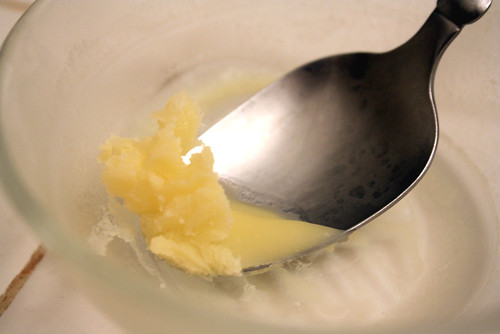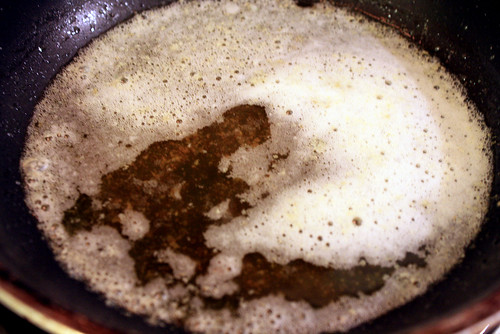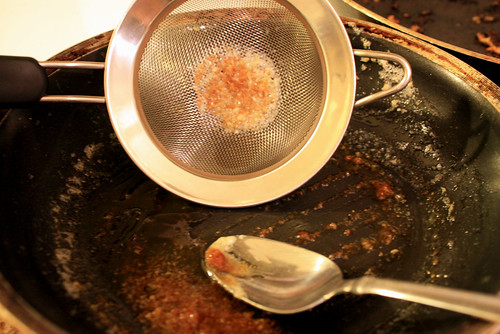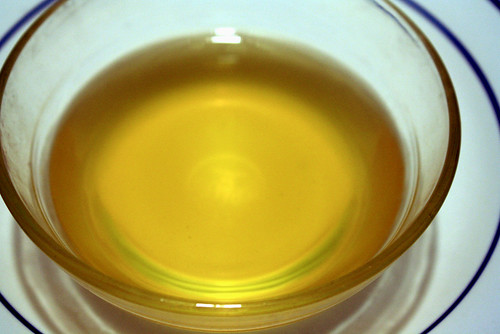
Ghee is an ancient fat, often used in Indian cooking, and one of the healthier fats to use in the kitchen.
Ghee is a clarified and nearly pure butter. Butter basically has three layers: water, fat, and milk solids. The water is simmered out and the milk solids are browned and strained out, leaving a lacto-free fat. The browned milk solids provide a nutty flavor and a pleasant depth to the ghee, and removing them from the ghee allows persons who normally cannot eat lacto or dairy foods to use and enjoy ghee in a variety of dishes. Ghee is therefore great for digestion and has been used through the ages in helping with ulcers and other digestive ailments. It is even used on burns to help reduce redness and help prevent scarring.
Since ghee is high in healthy saturated fat, it is naturally shelf stable and can be kept covered on the counter ready for use in any dish for several months (if it lasts that long); however, keeping it in the refrigerator is fine, too. Although ghee cools into a solid, it melts very quickly at low temperatures but also has a high smoke point between 325-375*F, above most temperatures needed for frying or cooking foods on high heat.
Ghee is composed of approximately 65% short-chain fatty acids of saturated fat, the healthy kind, as opposed to damaging long-chain fatty acids. It also has monounsaturated and polyunsaturated fats, as well as antioxidants from the clarification process. Plus it has four fat soluble vitamins - A, D, E, & K - meaning the body cannot absorb and utilize these essential nutrients without healthy fats.
I have not used ghee recently, although I've enjoyed it in dishes before. However, I saw the process on A Little Bit of Spain in Iowa and also need it for an upcoming food project. I want to share this basic step of making ghee to encourage its use in cooking as a healthy fat and one that's easy to make at home.
It is important to use organic butter when making ghee to ensure preservatives, lactic acid, and other additives are not present which greatly reduce the health benefits of ghee, as well as prevent it from being naturally lacto-free. And also be cautious of some ready made ghee which is often a vegetable substitute and overflowing with trans fats.
Organic Homemade Ghee
1 stick of butter
cheesecloth
In a shallow pan, melt one stick of butter over very low heat.
Once the butter is completely melted, turn the burner up a notch or two, but do not increase the heat over the medium setting. The butter should begin to foam, hiss, and bubble very slowly, but not boil. This process of evaporating the water should take between 10-15 min, depending on the heat of the burner; however, do not rush this step. Do not stir the butter during this entire process.
Once the water has evaporated, the butter will stop bubbling and hissing. The milk solids at the bottom of the pan will brown very quickly, so watch carefully. Using a spoon, gently push aside the foam and watch the milk solids for browning. The butter will suddenly smell very nutty when it begins to brown. Turn off the burner and remove the pan from the heat. Allow it to cool for 10 min.
Carefully strain the ghee through a cheesecloth into a clean jar or small bowl. Store covered on the counter, refrigerator, or freezer. Also, the browned milk solids are deliciously edible and can be added to other dishes with their nutty flavor, like with scrambled eggs.
~Yields 6 tbsp ghee.





Mmm ghee! I need to make some, soon! Thanks for the tips & information!
ReplyDeleteGreat post...I have never tried this but have heard about it. Now I will :)
ReplyDeleteAr ic! I will do it myself too.
ReplyDelete